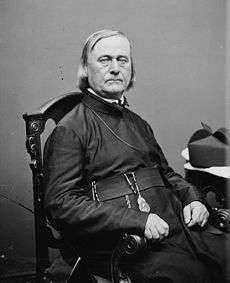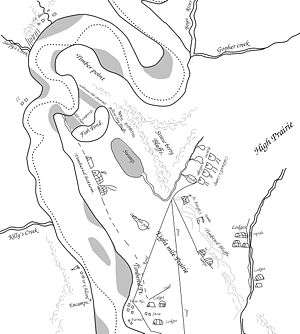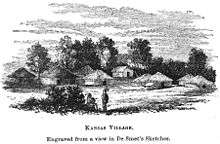Pierre-Jean De Smet
Pierre-Jean De Smet (Dutch and French IPA: [də smɛt]; 30 January 1801 – 23 May 1873), also known as Pieter-Jan De Smet, was a Belgian Catholic priest and member of the Society of Jesus (Jesuits). He is known primarily for his widespread missionary work in the mid-19th century among the Native American peoples, in the midwestern and northwestern United States and western Canada.
Fr.Pierre-Jean De Smet | |
|---|---|
 c. 1860-65, by Mathew Brady | |
| Born | 30 January 1801 |
| Died | 23 May 1873 (aged 72) |
| Other names | Pieter-Jan De Smet |
| Education | White Marsh Novitiate, present-day Bowie, Maryland |
| Church | Catholic |
| Ordained | 23 September 1827 |
His extensive travels as a missionary were said to total 180,000 miles (290,000 km). He was affectionately known as "Friend of Sitting Bull", as he persuaded the Sioux war chief to participate in negotiations with the American government for the 1868 Treaty of Fort Laramie.
Early life
De Smet was born in Dendermonde, in what is now Belgium in 1801, and entered the Petit Séminaire at Mechlin at the age of nineteen. De Smet first came to the United States with eleven other Belgian Jesuits in 1821, intending to become a missionary to Native Americans. He began his novitiate at White Marsh, a Jesuit estate near Baltimore, Maryland.[1] Part of the complex survives today as Sacred Heart Church in Bowie.
In 1823, De Smet was transferred to Florissant, Missouri, just north of St. Louis, to complete his theological studies and to begin his studies of Native American languages.[2] He was ordained a priest on 23 September 1827.
De Smet and five other Belgian novices, led by Charles Van Quickenborne, moved to Florissant, Missouri, north of St. Louis, at the invitation of bishop Dubourg. They founded several academic institutions, among which was the St. Regis Seminary, where De Smet had his first contacts with indigenous students. He learned about various Indian tribal customs and languages while serving as a prefect at the seminary.[3]
Around 1830, De Smet went to St Louis to serve as treasurer at the College of St. Louis. On 23 Sept. 1833, De Smet became an American citizen. He returned to Flanders that same year due to health problems and did not return to St. Louis until 1837.[3]

Mission work in Iowa Territory
| Part of a series on the |
| Society of Jesus |
|---|
 Christogram of the Jesuits |
| History |
| Hierarchy |
| Spirituality |
| Works |
| Notable Jesuits |
|
|
In 1838 and 1839, De Smet helped to establish St. Joseph's Mission in what is now Council Bluffs, Iowa, in Potawatomi territory along the Upper Missouri River.[1] These people had moved west from what is now Illinois. Taking over the abandoned Council Bluffs Blockhouse at the former United States military fort, De Smet worked primarily with a Potawatomi band led by Billy Caldwell, also known as Sauganash. (Of Mohawk and Irish descent, Caldwell was born in Ontario, Canada, on what is now the Six Nations Reserve. He was fluent in English and Mohawk, and some other Indian languages.)
De Smet was appalled by the murders and brutality resulting from the whiskey trade, which caused much social disruption among the Indian people. During this time, he also assisted and supported Joseph Nicollet's efforts at mapping the Upper Midwest. De Smet used newly acquired mapping skills to produce the first detailed map of the upper Missouri River valley system, from below the Platte River to the Big Sioux River. His map shows the locations of Indian villages and other cultural features, including the wreck of the steamboat Pirate.[4][5]
First missionary tour

wearing Leopold decoration
After discussion with members of various Iroquois nations from the East, the Salish Native Americans had gained a slight knowledge of Christianity. At a time when their people were afflicted by illnesses, they thought the new religion might help. Three times they sent delegations of their tribe more than 1,500 miles (2,400 km) to St. Louis to request "black-robes" from the Catholic Church to come to baptize their children, sick, and dying. The first three delegations failed to reach the city, due to disease and massacre while passing through the territory of the Sioux. A fourth delegation, in 1839, composed of some Iroquois who dwelt among the Flatheads and Nez Percês, was successful in reaching St. Louis.[1]
De Smet was assigned to journey to their territory, to determine their nation, and establish a mission among them. For safety and convenience he traveled with the American Fur Company brigade. On 5 July 1840, Father De Smet offered the first Mass in Wyoming, a mile east of Daniel, a town in the west-central part of the present state. A monument to the event was later erected on this site.[6]
In 1841, De Smet founded St. Mary's Mission in Montana among the Salish, and worked with them for several years. The following spring he visited François Norbert Blanchet and Modeste Demers, missionaries at Fort Vancouver. He noted that the Protestant proselytising of the American Board of Commissioners for Foreign Missions under Henry H. Spalding, based at Lapwai, had made the neighboring Nimíipuu (Nez Perce) nation wary of Catholicism.[7]
He persuaded a band of Nimíipuu to reside at St. Mary's for a period of two months; all of the people had received baptism before they left. Near the end of his time with the Salish, De Smet sent out an appeal to the United States public for financial aid to bolster his missionary efforts. He thought the Salish habit of seasonal nomadic movement made it "impossible to do any solid and permanent good among these poor people..."[7] He forwarded a plan proposing that the Salish "be assembled in villages—must be taught the art of agriculture, consequently must be supplied with implements, with cattle, with seed."[7] He went back to France to recruit more workers, and returned to the Pacific northwest via Cape Horn, reaching the Columbia River on 31 July 1844 with five additional Jesuits and a group of Sisters of Notre Dame de Namur.[3]
1845-1846 Canadian Rockies expedition

One of De Smet's longest explorations began in August 1845 in the region west of the Rockies that was jointly occupied by the Americans, who called it Oregon Country, and the British, who identified it as Columbia District. De Smet started from Lake Pend Oreille in present-day north Idaho and crossed into the Kootenay River Valley. He followed the Kootenay valley north, eventually crossing over to Columbia Lake, the source of the Columbia River at Canal Flats.
He followed the upper Columbia valley north to and past Lake Windermere. At Radium Hot Springs, he turned east and went over Sinclair Pass into the Kootenay River Valley. He recrossed the Kootenay and continued along the reverse of the route pioneered by the Sinclair expedition. He followed the Cross River upstream to its headwaters at Whiteman's Pass. The Cross River was named for the large wooden cross that De Smet erected at the top of the pass, where it could be seen from miles away.
On the other side of the Great Divide was the British territory of Rupert's Land. From the crest of the pass, streams lead to Spray Lakes above present-day Canmore, Alberta, and the Spray River, which joins the Bow River near modern-day Banff, Alberta. Once in the Bow Valley, De Smet headed upstream and in a north-westerly direction to its source Bow Lake. He traveled further north until he came to the Saskatchewan River, which he followed downstream and east.
It was October, and a long cold Canadian winter was looming, when he reached Rocky Mountain House. He had fulfilled one of his main goals; to meet with the Cree, Chippewa, and Blackfoot of the area. At the end of the month, De Smet traveled further to the east to search for more Natives. Fortunate to find his way back to Rocky Mountain House, he was guided by Indians from there to Fort Edmonton, where he spent the winter of 1845–1846.
During these years he established St. Mary's Mission in present-day Victor, Montana, among the Flathead and Kootenay Indian tribes . He also established the mission that became the Sacred Heart Mission to the Coeur d'Alene in present-day Cataldo, Idaho.[8]
In the spring of 1846, De Smet began his return, following the established York Factory Express trade route to the Columbia District. He headed west to Jasper House, and with considerable suffering followed the route. He crossed the Great Divide by Athabaska Pass, traveling to the Canoe River, the northern-most tributary of the Columbia River, and eventually on to Fort Vancouver, some thousand miles (1600 km) to the southwest.
He returned to his mission at Sainte-Marie on the Bitterroot River.
Later years and death
In 1854, De Smet helped establish the mission in St. Ignatius, Montana. It is located on the Flathead Indian Reservation. The current building was added to the National Register of Historic Places 100 years after his death.
In his remaining years, De Smet was active in work related to the missions which he helped establish and fund. During his career, he sailed back to Europe eight times to raise money for the missions among supporters there.
In 1868 he persuaded Sitting Bull to send a delegation to meet the U.S. peace commissioners, leading to the Treaty of Fort Laramie.
De Smet returned to St. Louis and from there made several trips to the north country helping Indians and teaching Christianity. In 1850 he cruised from Saint Louis to the Dakota territory aboard the steamboat Saint Agne, piloted by Joseph LaBarge. LaBarge was a close friend of De Smet, and always offered the services of his steamboat to the Catholic missionary effort.[9]
De Smet died in Saint Louis on 23 May 1873. He was originally buried at St. Stanislaus Seminary near Florissant, as were some fellow early Jesuit explorers. In 2003, the remains in that cemetery were moved to Calvary Cemetery in St. Louis, at the newer burial site for Jesuits of the Missouri Province.
Legacy
De Smet's papers, with accounts of his travels and missionary work with Native American nations, are held at two separate locations:
- Jesuit Archives - De Smetiana series in St. Louis, Missouri[10]
- Pierre Jean De Smet Papers at the Washington State University archives in Pullman, Washington[11]
- De Smet was featured as a major figure in the exhibition, Crossing the Divide: Jesuits on the Frontier (26 February - 27 June 2010), held at St. Louis University Museum of Art in St. Louis.
- The exhibit A Complex Vision: De Smet and the American Frontier (17 December 2014 – 2015), at St. Louis University Museum of Art, focused on him and his work.
- In 1968, he was inducted into the Hall of Great Westerners of the National Cowboy & Western Heritage Museum.[12]
Namesake places
Several places are named in honor of De Smet, including:
- De Smet, Idaho, a populated place
- DeSmet, Montana, a populated place between Wye and the Missoula International Airport
- DeSmet Junction, near Wye, where US 10, US 93 and MT 200 met (and where I-90 meets them today)
- De Smet, South Dakota,[13] the later childhood home of Laura Ingalls Wilder
- De Smet Jesuit High School in Creve Coeur, Missouri
- De Smet Range and Roche de Smet in Canada
- Lake Desmet, between Buffalo and Sheridan, Wyoming
- DeSmet Hall, the largest and oldest all-men's residence hall on the Gonzaga University campus in Spokane, Washington.
See also
- Red Fish, Oglala chief
References
- Fanning, William. "Pierre-Jean De Smet." The Catholic Encyclopedia Vol. 4. New York: Robert Appleton Company, 1908. 21 June 2019

- Literary St. Louis. St. Louis, Missouri: Associates of St. Louis University Libraries, Inc. and Landmarks Association of St. Louis, Inc. 1969.
- Davis, William L., "De Smet, Pierre-Jean", Dictionary of Canadian Biography, vol. 10, University of Toronto/Université Laval, 2003
- Whittaker (2008): "Pierre-Jean De Smet’s Remarkable Map of the Missouri River Valley, 1839: What Did He See in Iowa?", Journal of the Iowa Archeological Society 55:1-13
- Mullen, Frank. (1925) "Father De Smet and the Pottawattamie Indian Mission", Iowa Journal of History and Politics 23:192-216.
- Official State Highway Map of Wyoming (Map). Wyoming Department of Transportation. 2014.
- Smet, Pierre. Origin, Progress, and Prospects of the Catholic Mission to the Rocky Mountains. Fairfield, Washington: Ye Origin Galleon Press, 1972. pp. 9-11.
- Eberlein, Jake A., Wilderness Cathedral: The Story of Idaho’s Oldest Building, Mediatrix Press, 2017. ISBN 978-0692897652
- Chittenden, 1905, Vol. II, p. 62
- "De Smetiana". jesuitarchives.org.
- "Guide to the Pierre Jean De Smet Papers 1764-1970 (bulk 1821-1873) Cage 537". ntserver1.wsulibs.wsu.edu. Retrieved 27 July 2018.
- "Hall of Great Westerners". National Cowboy & Western Heritage Museum. Retrieved 22 November 2019.
- Gannett, Henry (1905). The Origin of Certain Place Names in the United States. Govt. Print. Off. pp. 105.
![]()
Sources
- Killoren, John J. 'Come, Blackrobe': De Smet and the Indian Tragedy, The Institute of Jesuit Sources (2003), reprint of the University of Oklahoma Press (1994); ISBN 1-880810-50-6
- ——; Richardson, Alfred Talbot; De Smet, Pierre-Jean (1905). Life, letters and travels of Father Pierre-Jean de Smet, S.J., 1801-1873, Volume II. New York : Francis P. Harper.
External links
| Wikimedia Commons has media related to Pierre-Jean De Smet. |